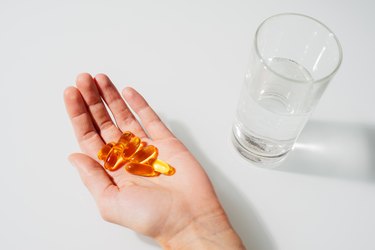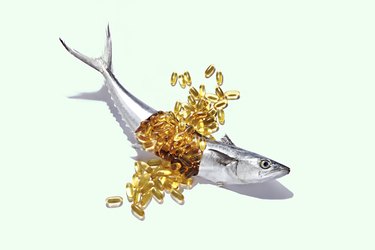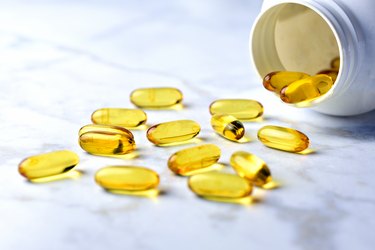
There are a lot of supplements on the market, and one of the most popular is fish oil. Fish oil is the primary source of two omega-3 fatty acids: eicosapentaenoic acid (EPA) and docosahexaenoic acid (DHA), according to the Mayo Clinic.
Omega-3s are linked to reduced inflammation and a lower risk of heart disease, plus improved cholesterol levels and arthritis symptoms. The amount of time it takes for fish oil supplements to take effect depends on a few factors.
Video of the Day
Video of the Day
How Long Does It Take Fish Oil to Work?
Fish oil supplements play the long game — there's no instant gratification, but you can achieve long-term benefits with time.
You shouldn't expect instant results with fish oil supplements, but your body should attain optimal levels within at least three months, says Jonathan Golberg, MD, a New York-based general practitioner.
Once you begin taking fish oil consistently, the omega-3 levels in your body will increase, but it still might take up to six months to see a noticeable difference, per the University of Wisconsin School of Medicine and Public Health.
Translation: It might take between three and six months for fish oil to work.
"It is a supplement you can take lifelong, but I'd suggest getting bloodwork done to really see what's going on," Dr. Golberg says. "In order to see benefits, I'd encourage getting cholesterol testing."
Tip
Taking higher amounts of fish oil won't translate to noticing the benefits any faster— in fact, large doses of fish oil can cause side effects and interact with other medications. Talk to your doctor before starting a fish oil supplement.
Influencing Factors
Effectiveness also depends on the starting point of your overall health. If you are deficient in omega-3s, the severity of the deficiency will influence how soon levels get back to normal.
The type of fish oil, or chemical form, also makes a difference. The omega-3 fatty acids in krill oil likely have a higher absorption rate than other forms of fish oil, according to the Cleveland Clinic.
What Happens When You Start Taking Fish Oil?
If you don't get enough omega-3s from your regular diet, supplementing with fish oil can help support heart, brain and eye health, according to the Cleveland Clinic. While fish oil can be helpful, it doesn't replace the need for a nutritious diet.
"Fish oil supplements do require consistency, but there can be big benefits when it comes to brain function and preventing chronic illnesses like heart disease and high blood pressure," says Alexa Topakas, RDN.
Intake Recommendations
The American Heart Association recommends eating two 3-ounce servings of fish each week.
Healthy sources of omega-3s include:
- Salmon
- Mackerel
- Trout
- Sardines
- Canned tuna
- Anchovies
Health Warnings
Taking too much fish oil (aka at least 900 milligrams of EPA plus 600 milligrams per day of DHA for several weeks) can cause negative side effects such as a weakened immune system and bleeding problems, per the National Institutes of Health.
If you take medications to treat diabetes or if you take blood thinners, fish oil supplements are not recommended until you talk to your doctor.
"Certain medications can have bad interactions with fish oil, even if it's a low dosage," Dr. Golberg says. "That's why it's important to talk with your doctor before starting any supplement routine. [Taking a supplement] might not be necessary."
Minor side effects can include gas, bloating and diarrhea. A solution to mild side effects is taking smaller doses during the day or using time-release supplements.
Is It Better to Take Fish Oil in the Morning or Evening?
If fish oil supplements are something you plan to incorporate into your daily routine, what's most important is that you take them consistently.
"The timing of the day for those medications shouldn't matter," Dr. Golberg says. Doctors agree it can be taken at any time of day, but what may have an affect is whether or not the supplement is taken with food.
A March 2019 study in Current Opinion in Clinical Nutrition and Metabolic Care suggests omega-3s are better absorbed when taken with a meal that includes a source of dietary fat (such as avocado, nuts or nut butters, seeds or olive oil). If taken on an empty stomach, there's a chance the body won't absorb the omega-3s as well.
"Whether it's taken in the morning with breakfast or at night after dinner, I do encourage clients to have a little something on their stomach in order to get the most out of it," Topakas says.
- Lipids in Health and Disease: Incorporation of EPA and DHA into Plasma Phospholipids in Response to Different Omega-3 Fatty Acid Formulations -- A Comparative Bioavailability Study of Fish Oil vs. Krill Oil
- American Journal of Clinical Nutrition: Distribution, Interconversion, and Dose Response of N-3 Fatty Acids in Humans
- Omega 3 Innovations: How Much Omega-3 Fish Oil a Day Will Produce Results?
- Journal of the Academy of Nutrition and Dietetics: Position of the Academy of Nutrition and Dietetics: Dietary Fatty Acids for Healthy Adults
- American Heart Association: Fish 101
- Linus Pauling Institute: Essential Fatty Acids
- Prostaglandins, Leukotrienes and Essential Fatty Acids: Long Chain Omega-3 Fatty Acid Immunomodulation and the Potential for Adverse Health Outcomes
- Mayo Clinic: "Fish Oil"
- University of Wisconsin School of Medicine and Public Health: "Omega-3 Fatty Acids: Some Frequently Asked Questions"
- Cleveland Clinic: "Fish Oil, Omega-3 Fatty Acids Capsules (OTC)"
- Current Opinion in Clinical Nutrition and Metabolic Care: "Strategies to improve bioavailability of omega-3 fatty acids from ethyl ester concentrates"
- Cleveland Clinic: "A Look at Krill Oil's Benefits"


